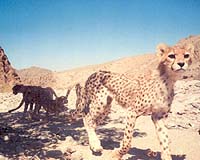| . |  |
. |
Phnom Penh (AFP) June 18, 2009 Pollution in southeast Asia's Mekong River has pushed freshwater dolphins in Cambodia and Laos to the brink of extinction, a conservation report said Thursday, sparking a furious government denial. The WWF said only 64 to 76 Irrawaddy dolphins remain in the Mekong after toxic levels of pesticides, mercury and other pollutants were found in more than 50 calves who have died since 2003. "These pollutants are widely distributed in the environment and so the source of this pollution may involve several countries through which the Mekong River flows," said WWF veterinary surgeon Verne Dove in a press statement. The organisation said it was investigating how environmental contaminants got into the Mekong, which flows through Cambodia, Laos, Myanmar, Thailand, Vietnam and the southern Chinese province of Yunnan. However, the Cambodian government official tasked with caring for the country's Irrawaddy dolphins said there remained "about 150 to 160" of them in the Mekong, and alleged the WWF's report used flawed research methodology. "It's big trouble -- they (the WWF) should resign. They should leave Cambodia," Touch Seang Tana, chairman of Cambodia's Commission to Conserve Mekong River Dolphins and Develop Eco-tourism, told AFP. "They published this without consulting me, and I'm the authority here," he said, adding he did not believe the river contained the pollutants listed in the WWF's report. The WWF said it suspected that high levels of mercury found in some dead dolphins came from gold mining activities. It added that Irrawaddy dolphins in Cambodia and Laos urgently needed a health programme to counter the effects of pollution on their immune systems. Inbreeding among the small population could have also contributed to weakened immune systems in the dead young dolphins, all of whom were under two weeks old. "The Mekong River dolphins are isolated from other members of their species and they need our help," said WWF Cambodia country director Seng Teak, adding the mammals "can show remarkable resilience" if their habitat is protected. The Mekong River Irrawaddy dolphin, which inhabits a 190-kilometre (118-mile) stretch in Cambodia and Laos, has been listed as critically endangered since 2004, the WWF said. Thousands of Irrawaddy dolphins once swam in the Mekong. Although regarded as sacred in Cambodia and Laos, their numbers were cut by the use of illegal fishing nets and Cambodia's drawn-out civil conflict, in which dolphin blubber was used to lubricate machine parts and fuel lamps. The Cambodian government, however, has been promoting dolphin-watching to attract eco-tourism and cracked down on the use of illegal nets which entangled them. It hopes such measures and establishing protected areas will raise their numbers over the next few years. The Mekong is one of only five freshwater habitats in the world for the Irrawaddy dolphin, and Cambodia is thought to support its largest remaining population. With their pale grey skin and blunt beaks, Irrawaddy dolphins resemble porpoises more than their sea-going cousins, and congregate in a handful of the Mekong's natural deep-water pools. The river is the world's largest inland fishery, producing some 2.5 million tonnes of fish per year valued at more than 2 billion dollars. The Mekong also provides 80 percent of the animal protein for 60 million people who live along its lower basin. Share This Article With Planet Earth
Related Links Darwin Today At TerraDaily.com
 Threatened cheetahs thrive in Namibia conservation project
Threatened cheetahs thrive in Namibia conservation projectWaterberg, Namibia (AFP) June 16, 2009 The three cheetah cubs roll around in the grass, totally involved in their game, the two males wanting to play with the wooden log their little sister has snatched away from them. "They had a bad start in life as their heavily pregnant mother was shot," said Leigh Whelpton, a volunteer at the Cheetah Conservation Fund (CCF) in Namibia. "The farmer who killed it, noticed movement in the ... read more |
|
| The content herein, unless otherwise known to be public domain, are Copyright 1995-2009 - SpaceDaily. AFP and UPI Wire Stories are copyright Agence France-Presse and United Press International. ESA Portal Reports are copyright European Space Agency. All NASA sourced material is public domain. Additional copyrights may apply in whole or part to other bona fide parties. Advertising does not imply endorsement,agreement or approval of any opinions, statements or information provided by SpaceDaily on any Web page published or hosted by SpaceDaily. Privacy Statement |